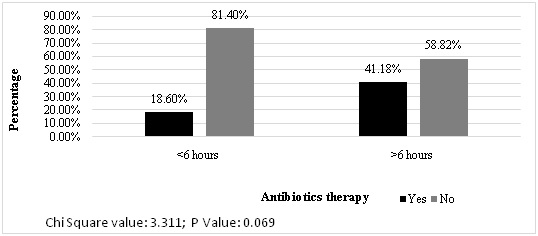Does delay in initiation of intravenous antibiotics correlate with wound infections in children with open fractures?
Abstract
Introduction: One of the common complications of open fractures is an infection which may be dependent on the time of administration of antibiotics. The study aimed to determine the prevalence of wound infection due to the delay in the interval between the initiation of intravenous (IV) antibiotics and time of paediatrics open injury.
Materials and Methods: Retrospective observational study included paediatrics patients (0 to 16 years) with open fractures. A retrospective chart review was performed to identify patients with open fracture, who were treated between May 2012 and October 2013 at the tertiary care centre. The time between the injury and the first dose of intravenous antibiotic was calculated from transfer and hospital records. Fracture groups were stratified according to the severity of soft-tissue damage as determined with use of the Gustilo- Anderson system for the classification of open fractures.
Results: Sixty patients with 84 open fractures were included in this study. Majority of 31.58% of participants had type III B Gustilo - Anderson fracture type. The proportion of grade IIIA, I, III C and II fracture was 29.82%, 21.05%, 14.04% and 3.51% respectively. 43 (71.6%) received IV antibiotics within 6 hours of injury of which eight had documented wound infections. Of the 17 (28%) patients who received IV antibiotics after 6 hours, 7 (41%) were diagnosed with wound infections. The incidence of infection was high in higher grades of Gustilo- Anderson opens injuries.
Conclusion: The immediate administration of appropriate antibiotics on presentation is crucial to minimise the risk of infection in children.
Downloads
References
2. Kay RM, Skaggs DL. Pediatric polytrauma management. J Pediatr Orthop. 2006;26(2):268-77.[pubmed]
3.Tscherne H, Sudkamp N. [Open fractures in children]. Z Orthop Ihre Grenzgeb. 1985;123(4):490-7.[pubmed]
4. Kleinman ME, de Caen AR, Chameides L, Atkins DL, Berg RA, Berg MD, et al. Pediatric basic and advanced life support: 2010 International Consensus on Cardiopulmonary Resuscitation and Emergency Cardiovascular Care Science with Treatment Recommendations. Pediatrics. 2010;126(5):e1261-318.[pubmed]
5. Patzakis MJ, Wilkins J. Factors influencing infection rate in open fracture wounds. Clin Orthop Relat Res. 1989(243):36-40.[pubmed]
6. Gustilo RB, Anderson JT. Prevention of infection in the treatment of one thousand and twenty-five open fractures of long bones: retrospective and prospective analyses. J Bone Joint Surg Am. 1976;58(4):453-8.[pubmed]
7. Lack WD, Karunakar MA, Angerame MR, Seymour RB, Sims S, Kellam JF, et al. Type III open tibia fractures: immediate antibiotic prophylaxis minimizes infection. J Orthop Trauma. 2015;29(1):1-6.[pubmed]
8. Swanson TV, Szabo RM, Anderson DD. Open hand fractures: prognosis and classification. J Hand Surg Am. 1991;16(1):101-7.[pubmed]
9. Merritt K. Factors increasing the risk of infection in patients with open fractures. J Trauma. 1988;28(6):823-7.[pubmed]
10. Kim PH, Leopold SS. In brief: Gustilo-Anderson classification. [corrected]. Clin Orthop Relat Res. 2012;470(11):3270-4.[pubmed]
11. Gosselin RA, Roberts I, Gillespie WJ. Antibiotics for preventing infection in open limb fractures. Cochrane Database Syst Rev. 2004(1):CD003764.[pubmed]
12. Ostermann PA, Seligson D, Henry SL. Local antibiotic therapy for severe open fractures. A review of 1085 consecutive cases. J Bone Joint Surg Br. 1995;77(1):93-7.[pubmed]
13. Harley BJ, Beaupre LA, Jones CA, Dulai SK, Weber DW. The effect of time to definitive treatment on the rate of nonunion and infection in open fractures. J Orthop Trauma. 2002;16(7):484-90. [pubmed]
14. Noumi T, Yokoyama K, Ohtsuka H, Nakamura K, Itoman M. Intramedullary nailing for open fractures of the femoral shaft: evaluation of contributing factors on deep infection and nonunion using multivariate analysis. Injury. 2005;36(9):1085-93.[pubmed]



 OAI - Open Archives Initiative
OAI - Open Archives Initiative


















 Therapoid
Therapoid

